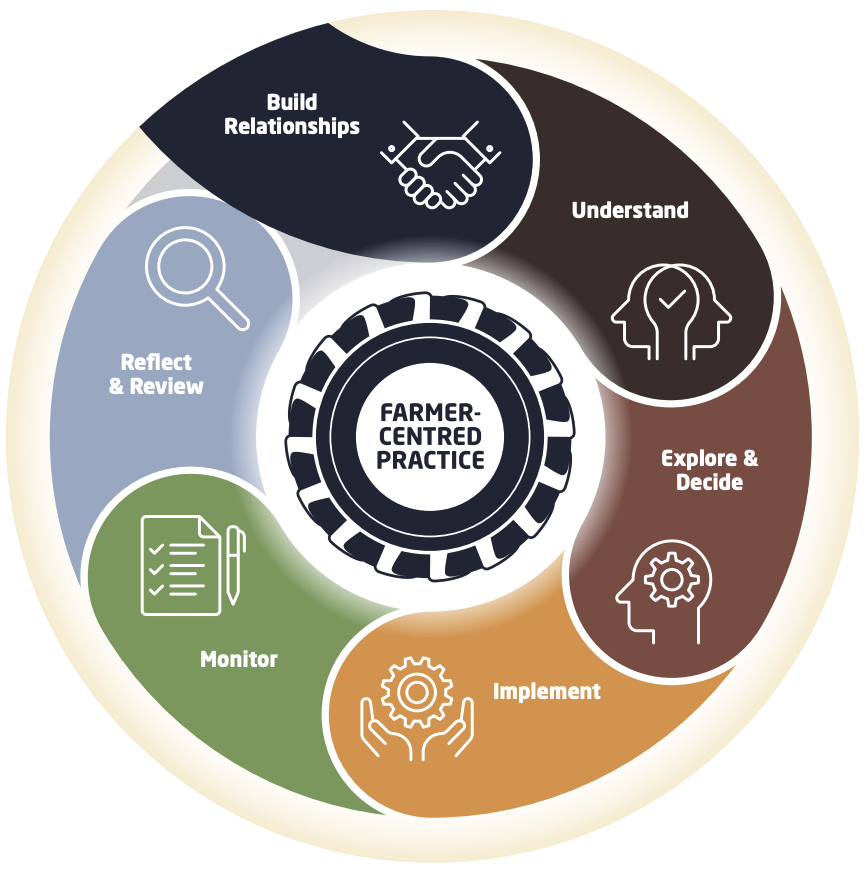“What we do is important, but how we do it makes the difference.” – Queensland Extension Model of Practice (2020)
“The Extension Model of Practice (EMoP) is a decision-making or service-delivery framework to guide the work of extension officers with individual farmers, groups of farmers, other extension staff and their organisations. It is designed to support extension officers to be intentional in their work, and have greater clarity about what they are trying to achieve and the factors and context likely to influence outcomes. The model is applicable at a number of levels. It can be used by the extension team when working with individual farmers, with groups of farmers or with each other.”
“The model provides the agricultural and environmental sectors with a lens with which to discuss, acknowledge and value the ‘practice’ of extension, and the interventions developed to facilitate desired change.” – (Williams, 2020)
The model is useful for any Extension Professional or for those planning Extension Projects and Programs. It was developed in Queensland and funded by the Queensland Government Reef Water Quality Program.
It can be accessed via this link: Williams, A., Sestak, D., Prichard, P., and Hall, J. (2020). Queensland Extension Model of Practice. What we do is important but how we do it makes the difference.
Farmer-Centred Practice
This focus is at the heart of the EMoP. The model takes a human-centred design method to problem solving in the practice of extension. It identifies and recognises the needs and experience of the farmer as vital for determining challenges and issues at hand and going on to find the best solutions.

“It is a way of thinking and working which views farmers and extension officers as equal partners in extension activities. It acknowledges farmers as the experts on their farms and in their lives. It requires extension officers to treat each farmer as an individual and focus on their strengths as a way of achieving their unique goals and outcomes.”
The Implementation Process
The model details the proposed change process to be used for farmer centred extension:

Implementation of the Model
The model documents that extension practice in Queensland (and it can apply to any jurisdiction), is reliant on the endorsement and support of relevant stakeholders. It proposes and details five implementation prerequisites that underpin the successful implementation of the model:
- Leadership
- A shared understanding
- Contextualisation
- Support and training
- Monitoring and review
“How do we bring key stakeholders on board with this model so they do not limit its potential or create barriers…. but enable it instead? We want and need to have a strong relationship with policy, decision makers and funding bodies as there is a disconnect. There is a need to value extension and its role in change and adoption”.
References and Further Information
Harris, L., Wood, L., Day, C., (2010), An ethnographic study into the Family Partnership Model: Implementation and sustainability. Centre for Parent and Child support/South London and Maudsley NHS Foundation Trust, London.
Moore, T.G. and Myers, J. (2020). Play2Learn Practice Framework: Walking alongside children and families. Prepared for Save the Children, Australia. Parkville, Victoria: Centre for Community Child Health, Murdoch Children’s Research Institute.
Perini, N., (2018), Implementation science: what is it?, SVA Quarterly. Accessed 23.7.20
Williams, A. (2020). Discussion Paper: Co-developing an Extension Model of Practice in Queensland. Funded by Queensland Government Reef Water Quality Program.
